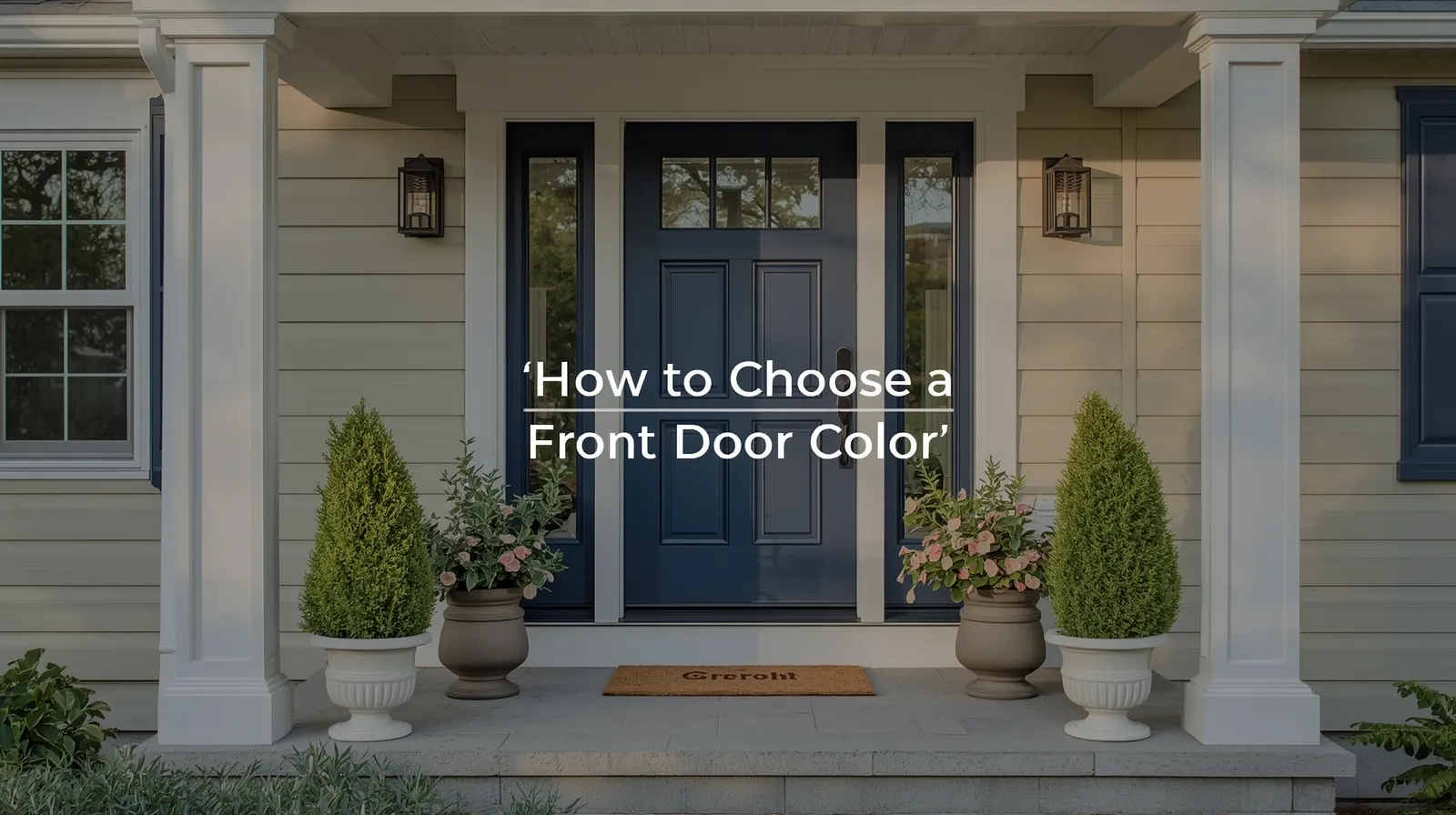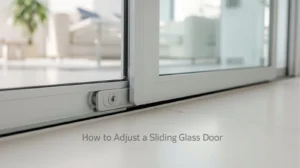A beautiful front door color can completely change how your home feels. Whether you’re trying to increase curb appeal, express your personality, or just make your house feel new again, the right color choice matters. This guide explains how to choose a front door color step-by-step, using simple and proven design ideas that anyone can follow. You’ll learn how lighting, house materials, and color psychology affect your choice. You’ll also explore popular shades for red brick, white, or neutral homes, along with practical painting tips. With advice from local experts and years of real experience, this article helps you make a color choice that adds warmth, confidence, and timeless charm to your home’s entrance.
Why Your Front Door Color Matters More Than You Think
Your front door isn’t just an entry point, it’s your home’s handshake. It welcomes guests, hints at your personality, and sets the tone for everything inside. When someone walks by or visits, their eyes are often drawn straight to your door before anything else. A well-chosen color can instantly make your home appear more elegant, cheerful, or bold.
Design experts say that your front door is one of the easiest ways to improve curb appeal without major renovations. It’s a small change that delivers big results. For example, a deep navy or forest green can make a traditional house look richer and more grounded, while a bright red or sunny yellow can energize a plain exterior. Even neutral shades like taupe, black, or charcoal add a touch of sophistication when paired with the right trim.
The color of your door also affects how you feel when you return home each day. A welcoming shade can bring a sense of pride, comfort, and happiness before you even step inside.
Understanding the Impact of Color on Your Home’s Curb Appeal
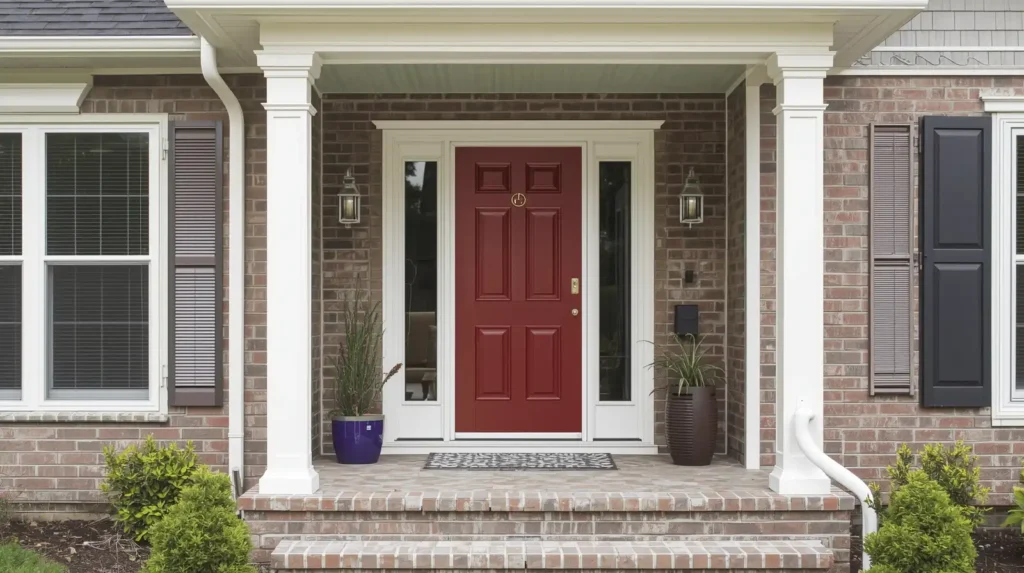
Color is one of the strongest design elements we respond to emotionally. Certain hues calm us, while others spark energy or confidence. Understanding how color affects your home’s look helps you make smart choices.
For instance, a red front door can feel bold and inviting it’s long been seen as a sign of good luck and warmth. A black door conveys power and elegance, giving your home a timeless and high-end look. Meanwhile, blue doors bring peace and stability, while green signals balance and renewal.
When viewed from the street, the front door often serves as a focal point. If your exterior is full of earthy tones like beige, brown, or tan, adding a strong contrast such as navy, plum, or teal can make the door pop beautifully. If your house is modern and white, a dark charcoal or even pastel color can create a balanced and tasteful design.
The trick is to think of your home’s exterior as a complete picture roof color, brick tone, siding, trim, landscaping, and even driveway color all affect how your front door appears from different angles.
How to Choose a Front Door Color That Matches Your Home’s Personality
Learning how to choose a front door color that truly fits your home starts with understanding its character. Every home has a personality. Modern houses lean toward clean, simple tones like matte black, charcoal, or steel blue. Farmhouse or cottage styles look stunning with warm colors such as sage green, sky blue, or barn red.
Take note of your architectural details. For example:
- Homes with stone or brick siding pair well with muted colors that echo natural textures.
- Stucco or painted siding allows more freedom for bold, saturated colors.
- Homes with dark roofs balance nicely with lighter door colors, while light roofs look better with deeper tones.
Also, consider your environment. Homes surrounded by trees and greenery look beautiful with natural hues like olive or brown. Beach-style homes shine with soft blue or turquoise. If you live in a busy city, darker shades resist dirt better and stay looking fresh longer.
It’s also smart to look at your neighborhood. You want your home to stand out, but not clash. Pick a color that fits the area yet still reflects your personality. The right front door color isn’t just about matching paint it’s about matching emotion and lifestyle.
Best Colors for Front Doors Based on Light, Shade, and Texture
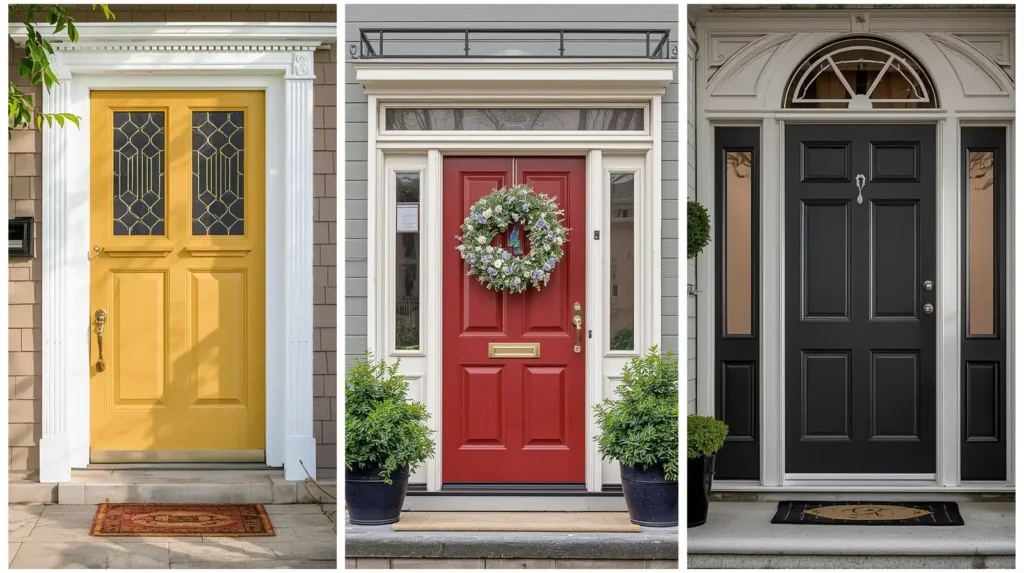
Light can completely change how a color appears. A front door that faces the sun most of the day will look lighter and more vivid, while shaded doors appear darker and cooler. That’s why testing paint samples under different lighting conditions is essential.
If your door gets strong sunlight, avoid overly bright colors like lemon yellow or pure red, since they can fade faster. Instead, pick mid-tones like deep teal, sage, or navy. For shaded entries, consider warm shades such as terracotta, soft gold, or creamy ivory to brighten the area.
Texture also plays a role. A wood door with visible grain can bring depth to earthy tones like walnut, honey, or forest green. A smooth fiberglass or metal door looks sleek in bold colors like glossy black, crimson, or sapphire blue.
Finish type matters, too. Satin or semi-gloss finishes make colors pop and resist dirt, while matte finishes create a softer, more natural look. If your home has detailed trim or panels, glossy paint can highlight those accents beautifully.
What Color Should I Paint My Front Door? Expert Advice Simplified
If you’re unsure what color to paint your front door, start by asking what feeling you want your entryway to give. Do you want something cheerful, calm, bold, or elegant?
Here’s a quick breakdown:
- Red – Bold and welcoming; great for traditional or farmhouse-style homes.
- Blue – Calm and relaxing; pairs well with gray or white exteriors.
- Black – Timeless and classy; ideal for modern homes.
- Green – Natural and refreshing; fits beautifully with brick or stone houses.
- Yellow – Friendly and bright; adds energy to neutral façades.
Also, check your surroundings. A home in a sunny region might benefit from cooler colors to balance the brightness, while homes in cooler climates look great with warm tones.
Finally, make sure to invest in high-quality exterior paint. Look for UV and moisture resistance. Most experts recommend a satin or semi-gloss finish it’s easier to clean and resists fingerprints. A fresh coat of primer also improves color richness and durability.
Front Door Color Meanings: What Each Shade Says About Your Home
Colors carry emotions. The shade you choose says something about who you are and how you want others to feel when visiting.
- Black: Strength, sophistication, and authority.
- Green: Growth, harmony, and balance with nature.
- Yellow: Warmth, joy, and optimism.
- Blue: Calmness, peace, and trust.
- Red: Passion, energy, and welcome.
- Turquoise: Creativity and a sense of openness.
- White: Simplicity, purity, and freshness.
Many homeowners love using color meanings to personalize their homes. For example, someone who loves calm environments may choose a soft blue or pale gray door. People who enjoy lively gatherings might go with coral or golden yellow.
It’s not about strict rules it’s about how the color makes you feel. The door becomes a mirror of your energy, greeting everyone who walks by.
Best Front Door Colors for Brick and Red Brick Houses
Brick homes are classic, but choosing the right door color requires balance. Red brick already has warmth, so the door color should complement, not compete.
Top choices for red brick houses:
- Navy blue: Elegant contrast that enhances both tones.
- Charcoal gray or black: Creates sophistication and timeless appeal.
- Sage green: Adds calm, natural balance to the warmth of brick.
- Crisp white: Clean and striking, especially with dark shutters.
- Soft cream: Warm and inviting for traditional designs.
Avoid shades that blend too closely with brick, such as bright red or orange, since they lose definition. Instead, use contrast to make your door a standout feature.
When your home has multi-toned brick, pull one of the softer secondary hues from the pattern for a subtle match. Pairing these shades with modern hardware or decorative glass makes the entrance feel complete.
Choosing the Right Front Door Color for White or Light-Colored Homes
White homes give you almost unlimited freedom to experiment with color. This is your chance to make a bold statement or craft a soft, elegant design.
Classic pairings include:
- Black door: Always timeless; fits every architectural style.
- Navy blue: Perfect for a coastal or colonial look.
- Bright red or coral: Adds personality and warmth.
- Hunter green: Earthy and rich, ideal for natural surroundings.
- Charcoal gray: Modern, clean, and balanced.
For soft neutrals like cream or beige exteriors, go with deeper, richer tones like plum, mahogany, or steel blue. The contrast adds depth without feeling harsh.
If you prefer a modern minimal look, monochrome tones such as white door with white trim create simplicity and calm. Add metal hardware for a sleek finish.
Remember, color is more than paint it’s emotion. The right door color transforms how your home greets both you and your guests.
Popular and Timeless Paint Colors for Front Doors
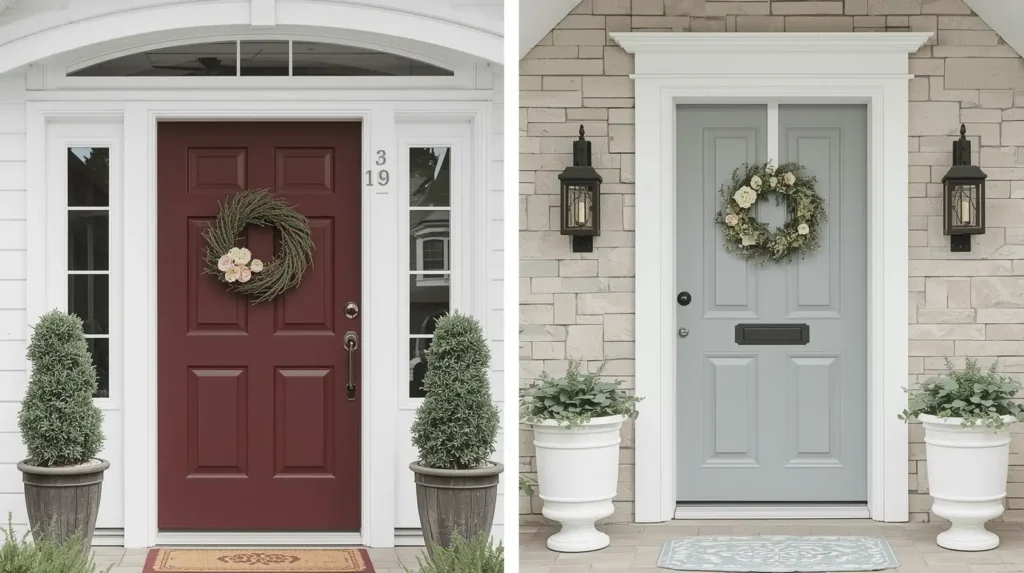
While trends change, certain front door colors stay stylish year after year. These shades are both reliable and flexible across different home styles.
Timeless favorites include:
- Navy blue: Polished and calming.
- Burgundy: Warm, rich, and traditional.
- Charcoal gray: Sleek and modern.
- Sage green: Natural and peaceful.
- Classic black: Bold yet balanced.
If you want a trendier touch, soft pastels like dusty rose, pale mint, or muted teal are becoming popular in modern neighborhoods. They look especially good on homes with white siding or stone textures.
Another timeless tip is to coordinate the front door color with your window frames, shutters, or even outdoor planters. When these small details tie together, the whole exterior feels intentional and complete.
Tips for Testing and Painting Your Front Door Like a Pro
Painting your front door yourself can be rewarding if done correctly. Here’s a simple step-by-step process professionals use:
- Clean thoroughly. Remove dirt, grease, and old paint flakes.
- Sand lightly. This helps the paint adhere evenly.
- Apply primer. Especially if changing from a dark to light color.
- Test swatches. Paint small areas and observe at different times of day.
- Paint thin coats. Use 2–3 light layers rather than one thick one.
- Let it dry fully. Rushing this step causes streaks.
- Seal for protection. A clear coat helps resist moisture and UV damage.
Choose a high-quality brush or roller made for exterior surfaces. Avoid painting on humid or rainy days, as this can affect how the color sets. With patience, you’ll achieve a finish that looks professional and lasts for years.
Bringing It All Together with Capstone Windows & Doors in Phoenix, AZ
At the end of the day, your front door is the centerpiece of your home’s exterior. It’s the part that guests notice first and the view you see every time you return home. The right color can make that experience feel welcoming, confident, and uniquely yours.
If you’re unsure where to begin, professionals like Capstone Windows & Doors offer personalized help. Their experts understand how color, materials, and climate work together especially in Phoenix, AZ, where sunlight can change how paint appears over time. From classic designs to custom finishes, they guide you through each step to make sure your door complements both your taste and your home’s style.
With years of trusted service, Capstone Windows & Doors continues to help homeowners upgrade their exteriors with quality, precision, and heart.
Start fresh today with expert help from Capstone Windows & Doors. From paint advice to full installation, their friendly team ensures your entryway stands out beautifully and lasts for years to come.

